 Are you working with social media influencers?
Are you working with social media influencers?
Wondering how to track the results of your influencer campaigns?
In this article, you'll discover how to determine the effectiveness of your influencer campaigns based on marketing goals.
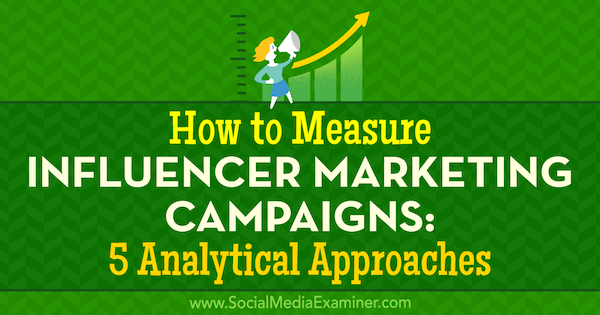
#1: Establish Campaign Reach via Followers, Post Impressions, and Referral Traffic
Reach is an essential ROI element for any influencer marketing campaign. You certainly want to see how far your brand message has traveled. The more reach your influencer marketing campaign has, the more potential sales you can net.
Measuring an influencer's reach can help you determine how many people potentially saw your brand's message. To examine influencer reach, measure the following key performance indicators (KPIs):
- Followers: The number of fans or followers an influencer has
- Impressions: The number of times your brand message gets in front of your target audience
- Traffic data: The amount of traffic an influencer is driving to your site
You can get this data from the social media profiles, as well as any tools that read social metrics. To see the info at a glance, create a dashboard or spreadsheet of your social media metrics.
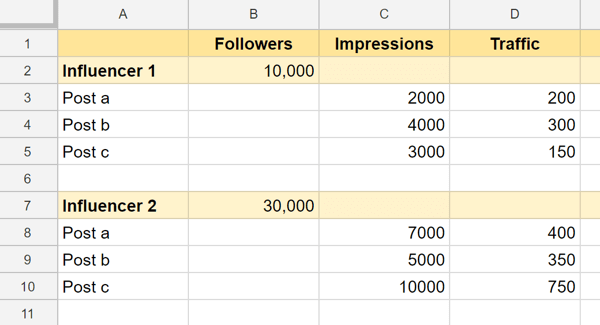
#2: Measure Campaign Engagement via Clicks, Likes, Reactions, and Shares
When your influencer campaign goal is engagement, you can measure not only the number of engagements, but also the cost per engagement (CPE). Influencer engagement essentially indicates the future of your brand loyalty among consumers and is a powerful way your brand can track long-term ROI.
To measure the engagement an influencer brings to your brand, track these types of engagements:
- Clicks: Clicks measure the interest level of your target audience, but you also want to have a good balance of clicks, likes, and shares.
- Likes: Likes will generate more buzz around your content and can boost your content's ranking on Facebook, too.
- Reactions: Facebook recently modified its algorithm to give greater weight to reactions. Facebook perceives reactions as requiring more effort, therefore indicating sentiment better than a basic like.
- Shares: Shares indicate quality. If people recommend your content to their friends and family, they'll recommend your products and services, too.

- Comments: A high number of comments on influencer posts indicates that your customers or potential customers like the post content.
- Brand mentions: Mentions are a great KPI because you know your content is being discussed and your brand amplified.
When you track engagements, you can then track CPE, which measures the money invested per click-through, like, comment, and so on. The CPE metric allows you to understand how consumers are reacting to your brand, and not solely to your products or services. In other words, CPE isn't simply about immediate sales, but also the customer relationship moving forward.
How do you calculate CPE? Divide your total ad spend by the number of engagements. You can do the math on your own or use an online calculator.
Alternatively, using a marketing tool such as BuzzSumo can give you an excellent overview of how well your influencer posts are doing. For example, with BuzzSumo, enter the URL for your site or a specific blog post to view its level of engagement. BuzzSumo shows you Facebook engagement and shares across different social media channels.
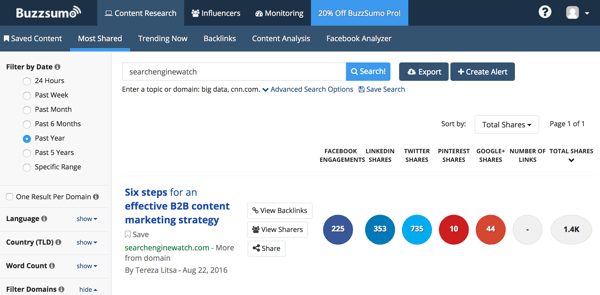
#3: Calculate Target Audience Growth via Google Analytics' Audience Overview Demographics
When you choose an influencer in your niche and produce content relevant to your brand, your impressions will be targeted to that niche. To make sure an influencer fits your target demographic, check out any potential influencers' Google Analytics.

Discover Proven Marketing Strategies and Tips
Want to go even deeper with your marketing? Check out the Social Media Marketing Podcast! Publishing weekly since 2012, the Social Media Marketing Podcast helps you navigate the constantly changing marketing jungle, with expert interviews from marketing pros.
But don’t let the name fool you. This show is about a lot more than just social media marketing. With over 600 episodes and millions of downloads each year, this show has been a trusted source for marketers for well over a decade.
Once you've partnered with relevant influencers who have a following that matches your target audience, don't stop tracking your demographics. Use this target audience KPI to your advantage. Check the Google Analytics Demographics report to ensure your brand message is reaching the right people.
Get World-Class Marketing Training — All Year Long!
Are you facing doubt, uncertainty, or overwhelm? The Social Media Marketing Society can help.
Each month, you’ll receive training from trusted marketing experts, covering everything from AI to organic social marketing. When you join, you’ll also get immediate access to:
- A library of 100+ marketing trainings
- A community of like-minded marketers
- Monthly online community meetups
- Relevant news and trends updates
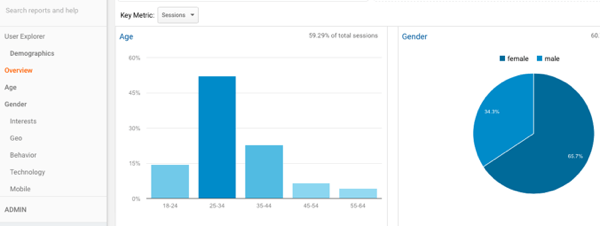
Measuring your influencer's grouping when it comes to your target audience allows you to make crucial changes to your strategy and maximize your ROI. An influencer who understands your audience well will collaborate with you to create content that elicits engagement and makes a lasting impression.
#4: Quantify Social Leads via Google Analytics' Acquistion Overview Report
Boosting visibility and having a more engaged target audience is fantastic; however, it's important to keep your ROI in mind. You want your influencer marketing campaign to generate leads to turn potential customers into buyers.
How many of your engaged followers are ready to buy your product or service? To maximize your ROI, you need to identify the influencers and marketing channels that are generating the most leads.
For instance, if you're getting more leads from Pinterest and fewer from Twitter, have your influencers produce more quality content for Pinterest. This will allow you to maximize your influencer marketing efforts by rechanneling your content to the platforms that work best.
How do you measure this influencer marketing ROI? Google Analytics is a fantastic place to begin. Go to Acquisition and then Overview to see your traffic channels. Next, in the list of traffic channels (Social, Organic Search, etc.), click Social.
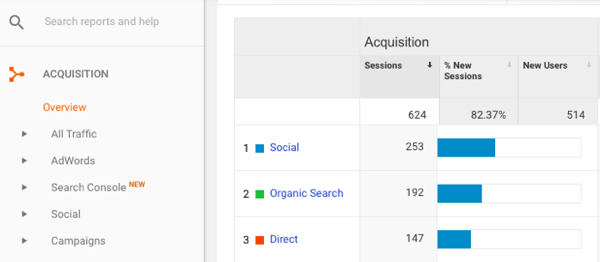
You then see a list of your leading social media channels. From there, you can evaluate the social channels that are generating the most potential leads from your influencer marketing campaign.
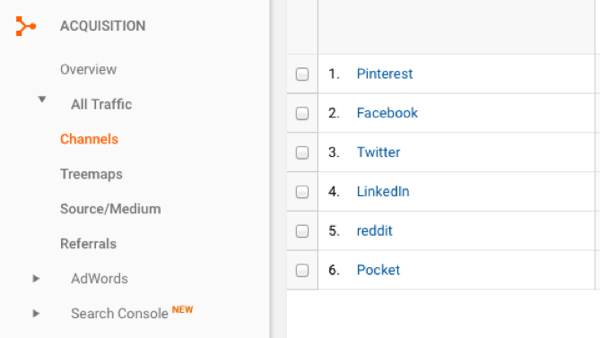
#5: Analyze the Origin of Sales via UTM Parameters
Powerful influencer marketing campaigns generate sales, which is the biggest ROI brands expect to see from their influencers. Use affiliate links, promo codes, and UTM parameters to help measure whether an influencer is generating a worthwhile number of sales.
Generating affiliate links for your influencers is by far the simplest way to examine your ROI in terms of sales. Influencers will receive a commission for driving customers to your site via these links. Also, affiliate links showcase click-through rate (CTR) to your site, the number of sales, and the average value of each purchase.
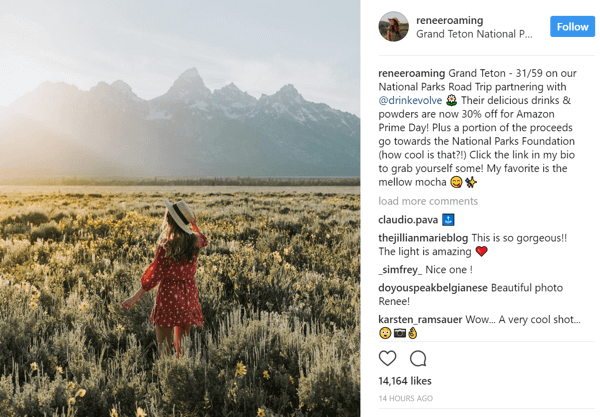
Promo codes are another great way to measure an influencer's impact on sales. When you designate promo codes for an influencer, your KPIs can go beyond sales. When customers use the promo code listed in the content, you can also track their future purchases, too.
Using Google Analytics Campaign URL Builder, you can add UTM parameters to URLs to track your influencer campaign in Google Analytics. You then receive data about the site where the ad appears, the campaign name, keywords used, and more.
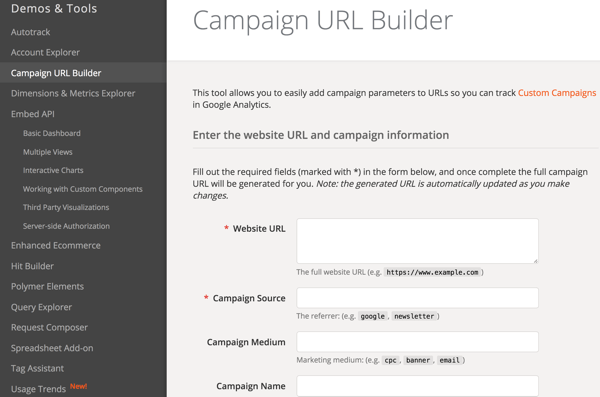
Conclusion
You can evaluate your influencer marketing campaign's impact in many ways. To choose which measurement is right for your influencer campaign, know your objectives for each campaign. Branding KPIs might interest large companies like Disney, whereas a small business might focus on generating direct sales. What you track depends on your goals and how the campaign is measured.
What do you think? Have you tried influencer marketing? What method has been the most successful for tracking your campaign performance? Please share your thoughts in the comments.
Attention Agency Owners, Brand Marketers, and Consultants

Introducing the Marketing Agency Show–our newest podcast designed to explore the struggles of agency marketers.
Join show host and agency owner, Brooke Sellas, as she interviews agency marketers and digs deep into their biggest challenges. Explore topics like navigating rough economic times, leveraging AI, service diversification, client acquisition, and much more.
Just pull up your favorite podcast app, search for Marketing Agency Show and start listening. Or click the button below for more information.

